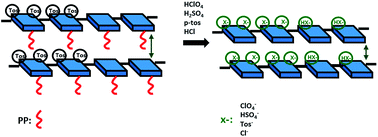Highly electrically conductive polyethylenedioxythiophene thin films for thermoelectric applications†
Abstract
In this study, we report the utilization of protonic acids to treat polyethylene glycol-triblock-polypropylene glycol (PP) modified polyethylenedioxythiophene (PEDOT) doped with tosylate (Tos−) counter-ion (PP-modified PEDOT:Tos) thin films. Investigations using absorption, Raman, electron spin resonance and X-ray photoemission spectroscopies indicate that nearly 100% enhanced electrical conductivity and over a 30% improved power factor observed from the PP-modified PEDOT:Tos thin films with protonic acid treatment are attributed to the increased densities of the polaron state and the stabilized densities of the bipolaron state. Further studies by grazing incidence wide angle X-ray scattering and atomic force microscopy reveal that the crystal structure, amorphous regions, and the size of the exchanging counter ion have great influences on the electrical conductivities, the Seebeck coefficients and the power factors. Our studies provide a facile route to realize highly electrically conductive polymers for the development of effective organic thermoelectric devices.


 Please wait while we load your content...
Please wait while we load your content...